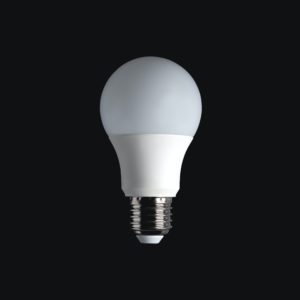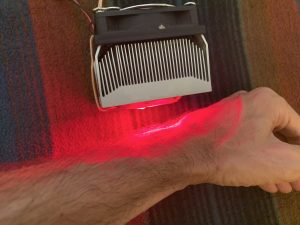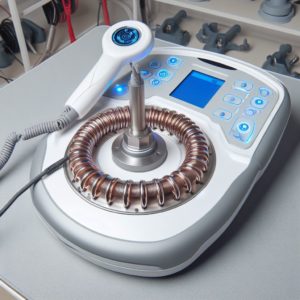Far-Infrared Radiation Therapy

Far-infrared radiation is a type of heat with a longer wavelength. Due to this longer wavelength, far-infrared radiation can generally penetrate further into the body than other types of heat. With far-infrared radiation, it is possible to heat the body more effectively at lower temperatures. For example, far-infrared saunas will cause a person to sweat at a lower temperature than a standard sauna. While the research is in its infancy, far-infrared radiation appears to have potential for helping to treat a number of different health conditions.
The Physics of Far-Infrared Radiation
Far-infrared radiation and other forms of heat are all electromagnetic fields (EMFs). EMFs have different properties based on their wavelength. At larger wavelengths, EMFs include radio waves used in radio communication systems and cell phones. As the wavelengths become shorter, electromagnetic fields start to be felt as heat. At even shorter wavelengths, EM radiation transitions from heat into the visible light that we see as different colors from red to violet. As wavelengths get even smaller, EMFs become more energetic, with ultraviolet light that can cause sunburns, X-rays and cosmic rays that come from outer space.
While there isn’t complete agreement, generally far-infrared wavelengths are considered to be between 3 and 1000 micrometers in length. A human hair is approximately 50 micrometers by way of comparison. Typically, if something feels warm to the touch but isn’t red hot, it’s emitting far-infrared radiation. Our bodies even produce it, mainly around the wavelengths between 10 and 14 micrometers (Yu 2012).
Potential Benefits
There are two main types of far-infrared therapy: active devices that use electricity to produce far-infrared radiation and passive devices that absorb heat and reemit it as far-infrared radiation. A lot of the research focuses on passive devices, although I am somewhat skeptical that they will produce enough far-infrared radiation to have significant physiological effects. Active devices include full-body far-infrared saunas and more targeted heating devices that treat specific areas of the body like the lower back. Perhaps in a future article, I will review the research on passive devices. As for now, this article will focus on active devices that produce far-infrared radiation, typically through an electronic heating element.
Whole-Body, Far-Infrared Sauna
Heart Health
A study on far-infrared sauna therapy for patients at risk of heart disease found improvements in heart parameters. Just fifteen minutes daily exposure for two weeks reduced systolic blood pressure by 15 points and improved antioxidant status (Masuda 2004). In a separate study by the same group, heart failure patients undergoing a similar protocol had improved heart rhythms (Kihara 2004).
A meta-analysis of far-infrared sauna therapy for heart failure found that 15 minutes daily, five times per week for two to four weeks improves short-term heart function (Källström 2018). However, longer studies are needed to see if the gains are maintained beyond four weeks.
Mental Health
A study of mildly depressed individuals with poor appetite were treated with a far-infrared sauna for 15 minutes daily, five days per week for four weeks (Masuda 2005). Physical and mental complaint scores decreased by 42% and 34% respectively. Appetite and relaxation levels also improved significantly.
Fibromyalgia and Chronic Fatigue Syndrome
Fibromyalgia is a common cause of chronic pain. The condition typically consists of widespread muscle and joint pain, fatigue, trouble sleeping and cognitive problems. For patients with fibromyalgia, ten far-infrared sauna therapy sessions provided significant benefits. After the first far-infrared treatment, pain levels were reduced by almost half. After ten sessions, pain levels were reduced even more, by just over 50%. Six months after the sauna sessions ended, pain levels were still reduced 44% on average.
In a similar trial for chronic fatigue syndrome, patients had levels of fatigue reduced by almost 30% after four weeks of far-infrared sauna therapy (Soejima 2015). Anxiety and Depression levels were also significantly reduced.
Type 2 Diabetes
In diabetics, 20 minutes of far-infrared saunas for three months reduced systolic blood pressure by 6.4 points with a trend towards decreased waist circumference (Beever 2010). There were no reported adverse events.
In a separate trial, patients with type 2 diabetes were treated with a far-infrared sauna for 20 minutes three times per week for three months (Beever 2010). Over the course of the study, patients were found to have improved quality of life, general health and physical health.
Lymphedema

Lymphedema is a condition where lymph drainage of the tissues is poor, resulting in a buildup of fluid, typically in an arm or leg. In one trial, patients were given two-hour, far-infrared sauna sessions, five days per week for four weeks. Swelling significantly decreased, while patient’s quality of life improved with far-infrared sauna treatment (Li 2017). A larger study by the same research group appeared to confirm the findings (Li 2017).
Targeted Far-Infrared Therapy
Allergies
Patients with nasal and sinus allergies were treated with a far-infrared emitter placed in front of their face for 40 minutes a day for seven days (Hu 2007). All allergy symptoms improved significantly over the week, including itchiness, runny nose, stuffiness and sneezing. Over the course of treatment, one patient dropped out of the study due to insomnia.
Painful Menstrual Periods
A study on adolescent girls with painful menses found benefits with far-infrared treatment over the lower abdomen. After a twenty minute treatment, pain, cramping and blood pressure were all significantly reduced (Hong 2011).
A separate study that used a hot pack combined with a ceramic that emits far-infrared radiation showed significant reduction in pain when used at night for up to three consecutive menstrual cycles (Lee 2011). After discontinuing for two cycles, pain levels were still reduced by 30% on average from the far-infrared treatment. While this study is arguably a passive far-infrared device, by including a source of heat (hot pack) the amount of far-infrared produced should be greater than a standard passive system alone.
Conclusion
Active far-infrared sauna treatments or more targeted far-infrared therapies appear to hold promise for helping to improve heart health, circulation, lymph flow and pain. While the results should be considered preliminary, when used properly, far-infrared radiation therapy appears to be quite safe. As the research continues, we can hopefully get a better understanding of the best approach to maximize the benefits from far-infrared technologies.



